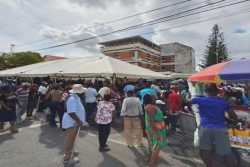-dismisses ‘pressure group’ as unlawful
Faced with growing dissatisfaction over prices being offered by rice millers for paddy, the Guyana Rice Producers’ Association (RPA) yesterday urged farmers to consider the effects of the “global crisis” on pricing.

RPA General Secretary Dharamkumar Seeraj told a news conference that the Association, the Guyana Rice Development Board (GRDB) and the Ministry of Agriculture will be meeting today with millers, who have not yet quoted prices for the year, to look at the issue.
The announcement comes after a group calling itself the RPA Action Committee told Stabroek News that many farmers are unable to “break even” as the production cost per acre has increased and millers are offering between $2,500 and $3,000 for a bag of paddy. Jinnah Rahman, the group’s spokesman, also said that the cost of production per acre varied, ranging between $96,000 and $140,000. Rahman emphasized that the RPA was “responsible for bargaining with rice millers to ensure that farmers are given fair prices” and said there would be reduced production if farmers were not given better prices and the local market would suffer. “Many farmers have taken out large loans and will not be able to pay their next instalments,” he said. “The prices being offered by the millers are not enough. Farmers will be forced to cut back on their production and that will increase local rice prices by three or five times.”
The increase in fuel prices, Rahman noted, has led to the increase in the cost for fertilizers and many other materials needed by rice farmers. It is this increase in prices that has caused production costs to peak, he said, and farmers are not only demanding, but need more for their paddy.
Rahman said last Friday he met with Seeraj, who was informed of the Action Committee but had objected to it.
Seeraj said while the RPA supports the group of farmers in their drive to get better prices for their crop, the committee is not legitimate.
He said it does not represent the RPA, which he explained is governed by a council and unless permission is given by that body no committee can be formed. Permission, he stressed, was not given at any time to the group to form a committee purporting to show that they were an arm of the RPA. “I am disappointed that an effort was not made by media bodies to contact the RPA,” Seeraj stated. “This should have been done to confirm whether the RPA was aware of any such committee. In fact, the spokesperson for that group is not even an RPA member.”
Seeraj attributed the prices offered for paddy to the “global crisis,” explaining that currently buyers on the world market want more at a time when credit is hard to obtain. Rice, he said, fetched a price of US$602 per tonne last year, and there has since been a significant drop. Lower prices on the world market, he added, will affect what rice millers can offer farmers for paddy.
The previous year’s trends in the industry should “be made a study,” Seeraj stated. According to him, the first crop last year saw high profits and the industry earned a significant amount. This, he added, encouraged farmers and millers to invest heavily. However, by mid-2008, he said, demands resulted in a rise in fuel prices and this took its toll on the production cost. As a result, Seeraj explained that the last crop in 2008 suffered.
In a statement issued yesterday the RPA said it could not determine prices since a free-market system existed in Guyana. The RPA further stated, “Current paddy prices are being influenced by global market forces because the highly-developed world is in total recession… it is unlikely that the millers would agree to a pricing structure formulated by the RPA.”
Farmers, he further stated, deserved no less than $4,000 per bag for paddy because of the high cost of production but at the same time they must realize that demand dictates prices.
Seeraj also disagreed with the production costs quoted by the Action Committee. The estimated average cost of production, the RPA secretary said, is $80,000. “The cost of production can be as low as $65,000 for some farmers,” Seeraj said. “High production costs range between $100,000 and $105,000. Anything higher is simply not realistic.” Efforts have been made to assist farmers, Seeraj further stated, duty has been removed from fertilizers and other chemicals, taxes reduced on diesel and concessions on taxes for tractor and combine parts has been facilitated.
MRL
Meanwhile, Seeraj stated that government intervention is needed to ensure that Mahaicony Rice Mills Limited (MRL), the country’s largest rice mill, pays farmers whom it owes more than $600 million for paddy it purchased during the “autumn” and “spring” crops last year.
He described the company’s treatment of rice farmers as “contemptuous”. “The Government has taken into consideration that the fiasco with non-payment to farmers by the Mahaicony Rice Mills can affect the entire rice industry and affect our capacity to reach our export targets if our farmers do not have the financial capacity to resume cultivation…” Seeraj stated, explaining that he tried to work with the company to pool resources. “Under the Financial Institutions Act, companies of a foreign nature can only borrow up to a fixed amount from the bank and Mahaicony Rice has exhausted its limit.” Seeraj further explained that he had contacted the Minister of Finance, Dr. Ashni Singh and requested that the legal borrowing limit applied to foreign entities under the Financial Institutions Act be lifted if MRL uses the funds to pay the rice farmers.
However, Seeraj said that Minister Singh had indicated that his ministry would be willing to make an exception in the case of MRL if the company was willing to provide a list of farmers and amounts owed to them. This way, he explained, the ministry would ensure that the farmers would benefit if the company’s loan portfolio was expanded.
MRL purchases 25% of Guyana’s rice and it accounts for 35% of rice exports, Seeraj stated adding that because the company accounts for such a large portion of the commodity anything it does can impact the industry.
This newspaper had reported on February 2 that the Guyana Rice Development Board (GRDB) in a press release had recalled that MRL General Manager Brandon Barton had made a commitment that all money from the spring crop last year would have been paid by December 31. MRL, the release had stated, had started paying for the second crop and aimed to complete this payment by the end of last month.




